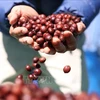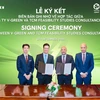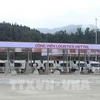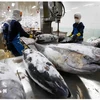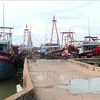Hanoi (VNA) – Building trademarks for maritime products is crucial for Vietnam to exploit sea resources in an effective and sustainable way, making Vietnam a strong country in terms of maritime economy.
With a total coastline of over 3,260km spanning across 28 provinces and cities, over 1 million square kilometers of exclusive economic zone and more than 3,000 islands and islets, including Hoang Sa (Paracel) and Truong Sa (Spratly) archipelagos, Vietnam’s potentials for sea-based economy are abundant.
The major target of the Vietnam maritime strategy to 2020 is to turn Vietnam into a country that has sea-driven strength and wealth. To this end, it is crucial to build an effective and sustainable maritime economy in line with the development of a strong sea and island trademark of Vietnam.
According to statistics from the Ministry of Natural Resources and Environment, more than 3,000 islands and islets of Vietnam has a total land area of 1,700 square kilometers.
Three islands having an area of more than 100 square kilometers are Phu Quoc in the southern province of Kien Giang, Cai Bau in the northern province of Quang Ninh and Cat Ba in the northern province of Hai Phong. There are 23 islands with more than 10 square kilometers in area, 82 others with area of over 1 square kilometers and more than 1,400 unnamed islets with high potential in tourism and economic development.
However, experts held that only a small number of islands have developed their own trademarks for their tourism and other products.
Many localities are still lacking suitable and comprehensive measures to make a master plan for the exploitation of their sea and island potential. They have underestimated potential of sea resources and environment. The building of maritime trademark has just begun.
The trademark of a maritime country is a collection of sea trademarks, which are not only marked with economic and business features but also with other areas, including names of place, recognised trademarks, and characteristics of culture, history, and prominent figures. It could easily leave strong impression and win customers’ interest.
Trademarks for maritime products are those developed for products and names attaching to the areas of navigation, seafood, tourism, natural resources, sea industries and maritime reserve areas.
The commercial products and names must be famous and become trademarks. A great number of businesses and localities with their strong maritime trademarks will help Vietnam become famous for its prestigious and high quality products.
In recent years, domestic and foreign consumers have become familiar to products with origin from Vietnam’s sea and islands, including Phu Quoc fish sauce, Ly Son garlic and Nha Trang bird’s nets, which have contributed to the growth of Vietnam’s sea and island trade mark.
Huynh Quang Hung, Vice Chairman of the People’s Committee of Phu Quoc district, said the locality has developed a pepper farm to the GlobalGAP standards that would help build the island into a centre for ecotourism, resorts and high-end entertainment nationally and internationally.
The farm is expected to serve as an attractive site for tourists, contributing to expanding the “Phu Quoc Peppercorn” trademark which was recognised by the Department of Intelligence Property in 2011.
Along with peppercorn, Phu Quoc fish sauce and mother-of-pearl are also among trademarks that are being developed by Phu Quoc, said Hung.
Meanwhile, Ly Son island of the central province of Quang Ngai, which is also known as the “Kingdom of Garlic,” is focusing on growing trademark for its garlic.
Garlic brings an income of 1.5-2 billion VND per hectare for islanders each year. The peak season for garlic harvest is in April and May when tourists flock to the island to experience garlic harvesting.
At the same time, the south central province of Khanh Hoa has also worked to promote its own trademark for Nha Trang birds’ net, and the northern coastal city of Hai Phong has been advertising its Cat Hai fish sauce and Cat Ba’s forest bee honey.
According to Vu Sy Tuan, deputy head of the Sea and Island Department under the Ministry of Natural Resources and Environment, the building of trademark for maritime products requires joint efforts of central and local levels.
He stressed the need for specific, proper and synchronic policies as well as strong enough resources.
Tuan also highlighted the necessity of close coordination and high consensus among ministries, sectors, localities and businesses to improve the exploitation of sea resources./.
With a total coastline of over 3,260km spanning across 28 provinces and cities, over 1 million square kilometers of exclusive economic zone and more than 3,000 islands and islets, including Hoang Sa (Paracel) and Truong Sa (Spratly) archipelagos, Vietnam’s potentials for sea-based economy are abundant.
The major target of the Vietnam maritime strategy to 2020 is to turn Vietnam into a country that has sea-driven strength and wealth. To this end, it is crucial to build an effective and sustainable maritime economy in line with the development of a strong sea and island trademark of Vietnam.
According to statistics from the Ministry of Natural Resources and Environment, more than 3,000 islands and islets of Vietnam has a total land area of 1,700 square kilometers.
Three islands having an area of more than 100 square kilometers are Phu Quoc in the southern province of Kien Giang, Cai Bau in the northern province of Quang Ninh and Cat Ba in the northern province of Hai Phong. There are 23 islands with more than 10 square kilometers in area, 82 others with area of over 1 square kilometers and more than 1,400 unnamed islets with high potential in tourism and economic development.
However, experts held that only a small number of islands have developed their own trademarks for their tourism and other products.
Many localities are still lacking suitable and comprehensive measures to make a master plan for the exploitation of their sea and island potential. They have underestimated potential of sea resources and environment. The building of maritime trademark has just begun.
The trademark of a maritime country is a collection of sea trademarks, which are not only marked with economic and business features but also with other areas, including names of place, recognised trademarks, and characteristics of culture, history, and prominent figures. It could easily leave strong impression and win customers’ interest.
Trademarks for maritime products are those developed for products and names attaching to the areas of navigation, seafood, tourism, natural resources, sea industries and maritime reserve areas.
The commercial products and names must be famous and become trademarks. A great number of businesses and localities with their strong maritime trademarks will help Vietnam become famous for its prestigious and high quality products.
In recent years, domestic and foreign consumers have become familiar to products with origin from Vietnam’s sea and islands, including Phu Quoc fish sauce, Ly Son garlic and Nha Trang bird’s nets, which have contributed to the growth of Vietnam’s sea and island trade mark.
Huynh Quang Hung, Vice Chairman of the People’s Committee of Phu Quoc district, said the locality has developed a pepper farm to the GlobalGAP standards that would help build the island into a centre for ecotourism, resorts and high-end entertainment nationally and internationally.
The farm is expected to serve as an attractive site for tourists, contributing to expanding the “Phu Quoc Peppercorn” trademark which was recognised by the Department of Intelligence Property in 2011.
Along with peppercorn, Phu Quoc fish sauce and mother-of-pearl are also among trademarks that are being developed by Phu Quoc, said Hung.
Meanwhile, Ly Son island of the central province of Quang Ngai, which is also known as the “Kingdom of Garlic,” is focusing on growing trademark for its garlic.
Garlic brings an income of 1.5-2 billion VND per hectare for islanders each year. The peak season for garlic harvest is in April and May when tourists flock to the island to experience garlic harvesting.
At the same time, the south central province of Khanh Hoa has also worked to promote its own trademark for Nha Trang birds’ net, and the northern coastal city of Hai Phong has been advertising its Cat Hai fish sauce and Cat Ba’s forest bee honey.
According to Vu Sy Tuan, deputy head of the Sea and Island Department under the Ministry of Natural Resources and Environment, the building of trademark for maritime products requires joint efforts of central and local levels.
He stressed the need for specific, proper and synchronic policies as well as strong enough resources.
Tuan also highlighted the necessity of close coordination and high consensus among ministries, sectors, localities and businesses to improve the exploitation of sea resources./.
VNA


